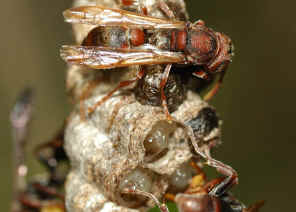- This page contains pictures and information about Vespoid Wasps that we found in the
Brisbane area, Queensland, Australia.
-
 -
- Vespoid Wasps feed on on nectar although their larvae are carnivorous.
-
- Vespoid Wasps have relatively small head with medium sized eyes and medium length antennae. The body is
slender with a narrow waist.
They have two pairs of brown-tinted wings, with the forewings larger. The abdomen has some
yellow bands on black. Adult wasps generally feed on nectar so they pollinate
flowers as well. The ovipositors in most wasps
are modified into stingers. All female Vespoid Wasps will sting if disturbed.
-
- Vespoid Wasps can be distinguished from Apoid
Wasps and Bees by the Vespoid Wasps
have the pronotum extends back to the base of forewings
-



-
- Vespoid Wasp larvae are carnivorous. They feed on
other insects and spiders. The adult female provide food for them by capturing prey or
by laying the egg on or near the food source. Female wasps spend most of their
time in finding food and making nest for their young
-
-



- Larvae.
Provisioning
Mating pair
-
- Most Vespoid Wasp species include solitary predators and parasitoids, but some of
them form highly social colonies. Vespoid Wasps include Spiders Wasps,
Flower Wasps, Paper Wasps, Potter
Wasps and Ants. The are listed in different families as follows.
- FAMILY
POMPILIDAE - Spider Wasps
- Most member in this family are large wasps. They are solitary insect.
Most of them are orange and black, the very strong warning colour. They hunt
for spider as prey, which they grasp and sting.



 
 
  -
- Family
MUTILLIDAE - Velvet Ants
- Wasps in this family are usually heavily sclerotised and with metallic
colours. Males are winged and look very different with female. Females are
wingless and ant-like, but can be distinguished by their curled antenna and
hairy body. Larvae parasite on other wasp, bee or ant nest.



-


 
-
- FAMILY TIPHIIDAE - Flower Wasps
- Species in this family are parasitic wasps which their larvae parasite on
soil insects such as burrowing beetles larvae and mole crickets. The female
Flower Wasps has to burrow through the soil to find the host and lay an egg on
it. The female legs are modified for digging and her wings are lost.



 






 -
- FAMILY SCOLIIDAE -
Hairy Flower Wasps
- Most member in this family are large wasps. They are solitary insect.
The larvae are ectoparasitoids of the grubs of
beetles.
The females burrow extensively in the soil to locate host grubs. They seems to
often utilize the burrows made by the grubs themselves. The females then paralyze
the grub and lay eggs on it.
-



-
- FAMILY VESPIDAE - Potter
Wasps and Paper Wasps
- Subfamily Eumeninae - Potter
Wasps
- Potter Wasps in Eumeninae build mud nest. They are solitary wasps. They
are typically black and yellow or black and orange in colours. Potter wasps usually prey on caterpillars which they paralyze
and place inside cells in their nests for their young. Nests are either dug into the ground,
constructed from mud, in wood, or in existing burrows of their hosts.
  
 

 



  - Subfamily Polistinae
- Paper Wasps
- Paper Wasps make their nests by chewing decayed wood mixing with their
saliva. A number of hexagonal shape cup cell grouped together to form a comb.
An egg is lay in each cell. The larvae develops and pupate inside the cell,
emerges and become an adult.

 





 




 -
-
 FAMILY FORMICIDAE
- Ants FAMILY FORMICIDAE
- Ants- All ants are in family Formicidae and all of them have waist. Their waist
is composed of one or two knobs which are the first one or two segment of
their abdomen. Their antennae have a distinct elbow. Ants live in colonies
made up of several castes. They included the winged male, winged female and
wingless workers.
-
-
- There are some other wasps that we cannot identify and listed in this
page.
-
- Reference:
- 1. Insects
of Australia, CSIRO, Division of Entomology, Melbourne University
Press, 2nd Edition 1991, pp 989.
- 2. Insects of Australia and New Zealand - R. J. Tillyard, Angus
& Robertson, Ltd, Sydney, 1926, p297.
- 3. Identification of European Wasp -Pests & Diseases, SARDI, South Australia.
- 4. What wasp is that? - An interactive identification guide to the Australasian families of Hymenoptera, 2007.
- 5. Hymenoptera of the world: an identification guide to families - By H. Goulet & J. Huber, eds. Agriculture Canada Publication 1894/E. 668 pp., 1993.
[ Home ] [ Pompilidae ] [ Mutillidae ] [ Tiphiidae ] [ Scoliidae ] [ Vespidae ] [ Other Predatory Wasps ]
Back to Top
|